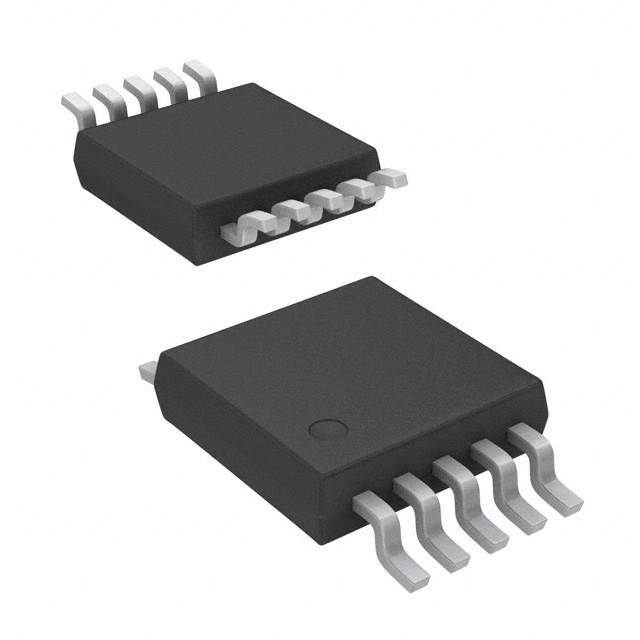Xem thông số kỹ thuật để biết chi tiết sản phẩm.

AD7790BRM
Product Overview
Category
The AD7790BRM belongs to the category of analog-to-digital converters (ADCs).
Use
It is primarily used for converting analog signals into digital data.
Characteristics
- High precision and accuracy
- Low power consumption
- Wide input voltage range
- On-chip programmable gain amplifier (PGA)
- Serial interface for easy integration
Package
The AD7790BRM comes in a small outline integrated circuit (SOIC) package.
Essence
The essence of the AD7790BRM lies in its ability to accurately convert analog signals into digital form, making it suitable for various applications.
Packaging/Quantity
The AD7790BRM is typically packaged in reels and is available in quantities of 250 units per reel.
Specifications
- Resolution: 16 bits
- Input Voltage Range: ±Vref
- Power Supply: 2.7V to 5.25V
- Operating Temperature Range: -40°C to +85°C
- Conversion Rate: Up to 470 samples per second
- Interface: SPI-compatible serial interface
Detailed Pin Configuration
- VDD: Power supply
- AGND: Analog ground
- AVDD: Analog power supply
- REFIN(+) and REFIN(-): Reference voltage inputs
- AIN(+) and AIN(-): Differential analog inputs
- DVDD: Digital power supply
- DGND: Digital ground
- SCLK: Serial clock input
- DIN: Serial data input
- DOUT: Serial data output
- CS: Chip select input
Functional Features
- Programmable gain amplifier (PGA) with gains of 1, 2, 4, or 8
- Internal reference voltage generator
- On-chip temperature sensor
- Data and status registers for easy control and monitoring
Advantages and Disadvantages
Advantages
- High precision and accuracy ensure reliable data conversion
- Low power consumption makes it suitable for battery-powered applications
- Wide input voltage range allows for versatile signal processing
- On-chip PGA simplifies signal conditioning
- Serial interface enables easy integration with microcontrollers
Disadvantages
- Limited resolution compared to higher-end ADCs
- Relatively slower conversion rate compared to some other models
- Requires external reference voltage for optimal performance
Working Principles
The AD7790BRM operates based on the principle of successive approximation. It samples the analog input voltage, applies a programmable gain, and converts it into a digital representation using an internal 16-bit ADC. The converted digital data is then made available through the serial interface.
Detailed Application Field Plans
The AD7790BRM finds applications in various fields, including but not limited to: - Industrial process control - Weighing scales - Temperature measurement systems - Data acquisition systems - Medical instrumentation - Portable devices
Detailed and Complete Alternative Models
Some alternative models that offer similar functionality to the AD7790BRM include: - AD7791: Higher resolution (24 bits) version of the AD7790BRM - AD7792: Dual-channel version of the AD7790BRM - AD7793: Lower power consumption version of the AD7790BRM
These alternative models can be considered based on specific application requirements and desired features.
Word count: 511 words
Liệt kê 10 câu hỏi và câu trả lời thường gặp liên quan đến ứng dụng AD7790BRM trong giải pháp kỹ thuật
Sure! Here are 10 common questions and answers related to the application of AD7790BRM in technical solutions:
Q: What is the AD7790BRM? A: The AD7790BRM is a low-power, low-noise, 16-bit sigma-delta ADC (Analog-to-Digital Converter) designed for precision measurement applications.
Q: What is the input voltage range of the AD7790BRM? A: The AD7790BRM has a differential input voltage range of ±VREF/2, where VREF is the reference voltage supplied to the ADC.
Q: What is the resolution of the AD7790BRM? A: The AD7790BRM has a resolution of 16 bits, which means it can represent analog signals with 2^16 (65,536) different levels.
Q: What is the maximum sampling rate of the AD7790BRM? A: The AD7790BRM has a maximum sampling rate of 470 samples per second (SPS).
Q: How does the AD7790BRM communicate with a microcontroller or other digital devices? A: The AD7790BRM uses a serial interface (SPI) to communicate with external devices.
Q: Can the AD7790BRM operate on a single power supply? A: Yes, the AD7790BRM can operate on a single power supply ranging from 2.7V to 5.25V.
Q: Does the AD7790BRM have built-in programmable gain amplifiers (PGAs)? A: Yes, the AD7790BRM has two integrated PGAs that can be configured to amplify the input signal by 1, 2, 4, or 8 times.
Q: What is the typical power consumption of the AD7790BRM? A: The AD7790BRM has a typical power consumption of 1.5mW at a 3V supply voltage.
Q: Can the AD7790BRM be used in temperature measurement applications? A: Yes, the AD7790BRM can be used for temperature measurement by connecting a temperature sensor to its inputs and using appropriate signal conditioning.
Q: Are there any evaluation boards or development kits available for the AD7790BRM? A: Yes, Analog Devices provides evaluation boards and software tools that can help with the development and testing of applications using the AD7790BRM.
Please note that these answers are general and may vary depending on specific application requirements and configurations.

